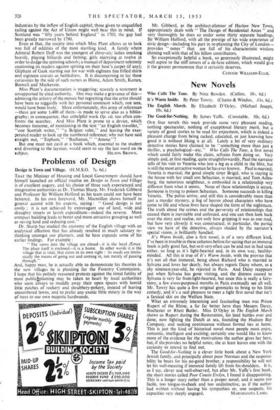Problems of Design •
Design in Town and Village. (H.M.S.O. 7s. 6d.)
THAT the Minister of Housing and Local Government should have himself launched an official treatise on Design in Town and Village is of excellent augury, and his choice of three such experienced and imaginative authorities as Dr. Thomas Sharp, Mr. Frederick Gibberd and Professor Sir William Holford as his team could not have been bettered. In his own foreword, Mr. Macmillan shows himself in general accord with his experts, saying : "Good design is not costly ; it is not achieved by extravagant use of land, wide and draughty streets or lavish expenditure—indeed the reverse. More compact building leads to better and more attractive grouping as well as saving land and reducing cost."
Dr. Sharp has studied the anatomy of the English village with an analytical affection that has already resulted in much salutary re- thinking amongst our planners, and he here expands some of his earlier findings. For example :
"The views into the village are closed—it is -the local climax. The place itself is enclosed—it is a home. In other words it is the village that is vital, that exists in its own right : its roads are intrin- sically the means of going out and corning in, not merely of passing through."
And, happy man, he is actually able to demonstrate his theories in the new villages he is planning for the Forestry Commission. I hope that his politely reasoned protests against the timid futility of most publiciplanting may be taken to heart by, local authorities who seem always to muddle away their open spaces with horrid little patches of rockery and shrubbery-pokery, instead of leaving uncumbered lawns, and to prefer any exotic little misery in the way of trees to our own majestic hardwoods. Mr. Gibberd, as the architect-planner of Harlow New Town, appropriately deals with 1` The Design of Residential Areas' and very thoroughly he does so under some thifty separate headings. Sir William Holford, with all the pfestige of his wide experience of civic design—including his part in re-planning the City of London— provides " notes " that are full of his characteristic wisdom chiming well with that of his fellow contributors.
So exceptionally helpful a book, so generously illustrated, might well aspire to the stiff covers of a de-luxe edition, which would give it the greater permanence that it certainly deserves.
CLOUGH WILLIAMS-ELLLS.


































 Previous page
Previous page